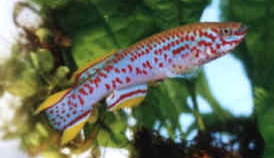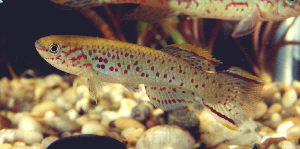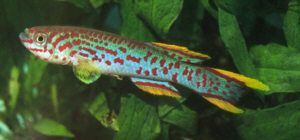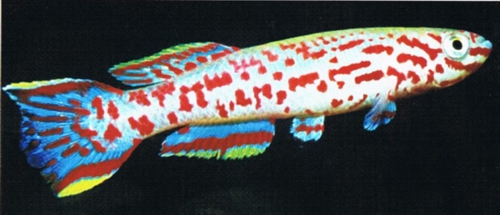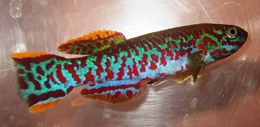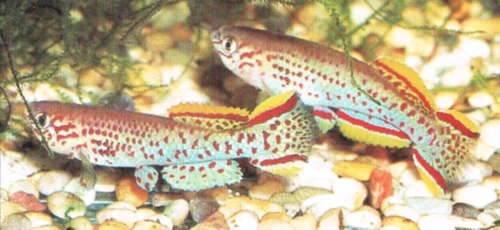Fundulopanchax nigerianus (Clausen 1963)

Fp.nigerianus. Photo courtesy of Ed Pürzl.
| Meaning of Name |
After Nigeria & the River Niger. | ||||||||||
| First Description |
Clausen H.S. 1963. (Aphyosemion nigerianum). Description of three new species of Aphyosemion Myers from Nigeria & Cameroun. Videnskabelige Meddeleser fra Dansk Naturhistorisk Forening 125: p 197-201, figures A-C. | ||||||||||
| Size |
7 cm. | ||||||||||
| Meristics |
| ||||||||||
| Karyotype |
n = 18-20, A = 27-33 (Scheel 1972) | ||||||||||
| Sub-Genus |
Paraphyosemion | ||||||||||
| Group |
gardneri | ||||||||||
| Synonyms |
| ||||||||||
|
Populations This is a very complicated species of vastly varying colour forms even within a population. Click population links (where available) below for more information/images). |
Because this species has so many populations & these can vary even within a population so many photographs can be included I have split the populations up into there own pages. Just a few photos are put on this page for comparisons. Please follow links in blue. Abakaliki - This population may be Abakalbi. I did a search for this name but it could not be found. Toyin Ojo considered Abakaliki to be the true name. This population has most probably not been in the UK. A line drawing was put into the BKA newsletter No.322, July 1992, page 14 but I am unable to insert it due to copyright problems. Abuja - See the Abuja page.
Akkamkpa - Fred Wright collected here
in the '70's & was adamant that the village had 2 k's. The site
has been adjusted accordingly.
Baissa - See the Baissa page.
Dumbo - ADL 13 / 16 - Link to Stofmania site with video & photo's from the location. Water Temperature 18·3 °C, pH 6.5, Conductivity 20 µS.
NTC 07 / 2 - Collected by Thibault Cavelier 2007 14 kms north of Iwo on the road to Oban. See DKG Newsletter 42 (3) for photo. Weh - ADL 13 / 20 - Already
a corrupted spelling going around - Wei is not correct. | ||||||||||
| Type Locality |
Arum, north of Wamba & on the foothills south west of the Jos Plateau. The biotope was a swamp. | ||||||||||
| Distribution |
This species has a large distribution area covering the River Niger delta in the south of Nigeria northwards to the Jos River Plateau & on towards Kano which appears to be the northern boundary. Eastwards, distribution follows the River Benue into the Cameroon mountains where the Misajé population is found. Click link to map of gardneri distribution. This comprises all populations I can find on maps. You can zoom in but markers are not accurate to the exact collection spot, just the area which builds up a picture of distribution. map |
||||||||||
| Habitat |
With such a wide distribution area it's not surprising that this species is found in a variety of biotopes. They have been caught in mountain streams (Misajé), 200 foot wide rivers (Makurdi), seasonal flood plains (Lokoja) & small roadside pockets of water. Also known to inhabit swampy parts of pools, brooks & small streams in secondary forested areas. | ||||||||||
| Distinguishing Characteristics | A very variable species. | ||||||||||
| Colour/Pattern Variability | High. | ||||||||||
| History |
First recorded collection of this species goes
back to 1955 where H.S.Clausen discovered them at Akure, western Nigeria.
The type specimens (eight in all) were collected by Clausen in 1963 at Arum which is situated to the south west of Jos Plateau in the foothills. At first they were considered to be a new species & he named them Aphyosemion (Fundulopanchax) nigerianus Clausen 1963. He also collected many other forms from other areas of Nigeria. Scheel later conducted crossing experiments with material from Eyoumojok & found them to be genetically related.
Black & white photos (parts)
in 'Naturalists Guide to Freshwater Fish' by J.J.Hoedeman showing some
of the earliest fish imported. A visiting German aquarist (unnamed) came to the UK on January 17th 1966 & brought with him a few sp. including eggs of the then known A.nigerianum. This was probably the first introduction to the UK. See BKA Killi-News No.7, March 1966. | ||||||||||
| Breeding Notes |
An easy species to breed, laying eggs on top & bottom mops. They will also lay in peat. Eggs are very tough & capable of withstanding fairly long periods of dry incubation. The Lokoja population is well adapted to this capable of dry storage periods up to two months. Other populations will take 4-6 weeks of dry incubation on damp peat. Fry are large enough to take newly hatched brine shrimp on hatching. Scheel found that eggs taking a long time to hatch (resting fry) did so 'depending on the type of water used for the eggs' although he did not say what the types were. See BKA newsletter No.387, December 1997. | ||||||||||
| Diameter of Egg | 1.4 mm. | ||||||||||
| Remarks |
|

